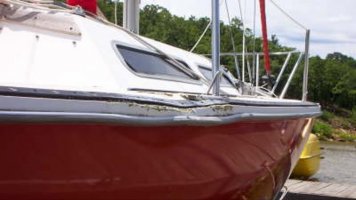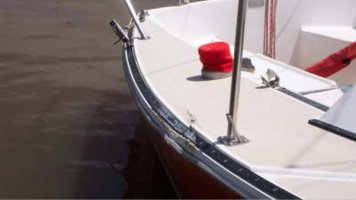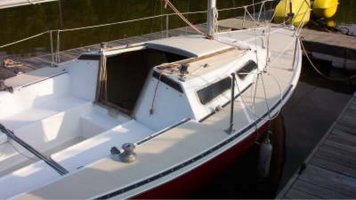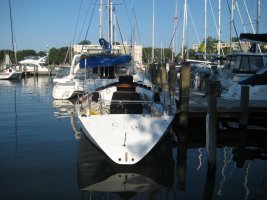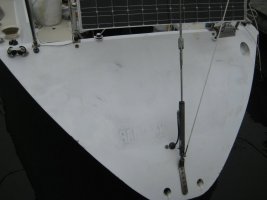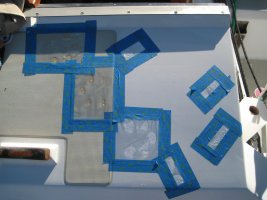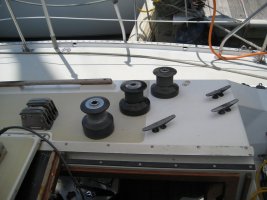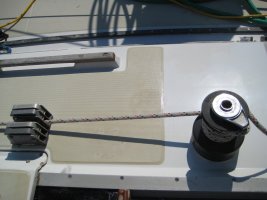You are using an out of date browser. It may not display this or other websites correctly.
You should upgrade or use an alternative browser.
You should upgrade or use an alternative browser.
54 screw holes...
- Thread starter alcodiesel
- Start date

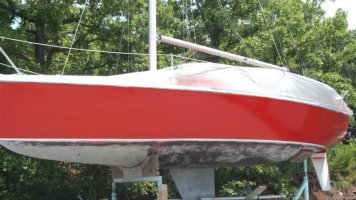
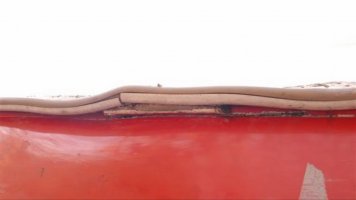 First two are the damaged deck and the rubrail and oil Canned hull. The last one is the repainted hull and new gelcoat on the deck. The rubrail was 1 section that was 25' long delivered from California. The track was 14' long- bolted every 6" and a total pain in the but to replace.
First two are the damaged deck and the rubrail and oil Canned hull. The last one is the repainted hull and new gelcoat on the deck. The rubrail was 1 section that was 25' long delivered from California. The track was 14' long- bolted every 6" and a total pain in the but to replace.More photos of deck repair. You can see a cut line and the glass that was removed.
Last edited:
markvone
Sustaining Member
Hi Chris,
How hard do you think it would be to roll or spray gelcoat on the transom of a Holland designed Ericson?
This surface takes a beating from the sun and elements because it is angled up toward the sky. My transom is pretty typical. It has had several names painted on and then removed. It had a wind vane at one time and the mounting holes have been filled. There are several chips along the port and stbd edges where the transom has a thin, sharp edge where it turns 90 degrees to each side. It looks like it had a paint over at some point and there are now stress and spider cracks in places as well as some chalky paint and primer bleed through.
I have seen several Holland designed Ericsons with painted transoms that looked pretty good. The transom shape with it's defined edges and no requirement to blend paint is a good candidate for painting even if the rest of the boat is still gelcoat. Because it's hard to see the transom at the same time as the sides of the boat, the color match doesn't need to be perfect.
I was planning to re-paint the transom when I re-do my vinyl name graphic but I'm now thinking of taking my own advice and re-gelcoating instead.
Mark
How hard do you think it would be to roll or spray gelcoat on the transom of a Holland designed Ericson?
This surface takes a beating from the sun and elements because it is angled up toward the sky. My transom is pretty typical. It has had several names painted on and then removed. It had a wind vane at one time and the mounting holes have been filled. There are several chips along the port and stbd edges where the transom has a thin, sharp edge where it turns 90 degrees to each side. It looks like it had a paint over at some point and there are now stress and spider cracks in places as well as some chalky paint and primer bleed through.
I have seen several Holland designed Ericsons with painted transoms that looked pretty good. The transom shape with it's defined edges and no requirement to blend paint is a good candidate for painting even if the rest of the boat is still gelcoat. Because it's hard to see the transom at the same time as the sides of the boat, the color match doesn't need to be perfect.
I was planning to re-paint the transom when I re-do my vinyl name graphic but I'm now thinking of taking my own advice and re-gelcoating instead.
Mark
Attachments
You can spray, but the little preval sprayers suck.
i am sure you can do the transom, I was just sure to keep it thin so it would not crack. I need to do mine as well, the scuppers are chipping on my Holland.
i am sure you can do the transom, I was just sure to keep it thin so it would not crack. I need to do mine as well, the scuppers are chipping on my Holland.
I hired a local freelance yacht painter to paint my transom with two-part paint. $300. He rolled and tipped.
I might try it myself, next time, after watching him. Even Brightside would be fine, and I can do that.
Gelcoat may be better, but the new paints are amazingly shiny and long-lasting.
I might try it myself, next time, after watching him. Even Brightside would be fine, and I can do that.
Gelcoat may be better, but the new paints are amazingly shiny and long-lasting.
Last edited:
markvone
Sustaining Member
Hole filling gelcoat tips
Hi Bill,
I just found the article I used to fill my holes. I got it off the web. It looks like its from a West Wright Potter owner. Here's the link:
http://blumhorst.com/potterpages/gelcoat
Note that the article uses polyester resin under the gelcoat repair, not epoxy. My Evercoat gelcoat repair kit says to use polyester resin under the gelcoat. Not sure if this is critical for small areas like holes. Since epoxy bonds better to existing fiberglass for repairs, I'm planning to epoxy in a polyester glass covered plywood disc in the 3.5 inch holes for my display repairs and then gelcoat over the polyester surface.
The color of the repair filler can influence the color match of the gelcoat for white and lighter colors. The West System low density filler (407) I used for my repair filler is red. A better choice for under white gelcoat would be colloidal silica (406) or even high density (404) which are both white. I wound up drilling out the top half of the repair filler because I used epoxy resin so I didn't have any color bleed through the white gelcoat.
I used regular gelcoat not the waxed version. I covered the holes with plastic pieces of heavy Ziploc freezer bags to get it to cure hard. A smooth surface for the plastic is more important for larger smooth repairs to minimize sanding. For smaller holes, overfill the hole as the gelcoat shrinks. Plan to sand the excess off until just the round hole diameter is left.
Mark
Hi Bill,
I just found the article I used to fill my holes. I got it off the web. It looks like its from a West Wright Potter owner. Here's the link:
http://blumhorst.com/potterpages/gelcoat
Note that the article uses polyester resin under the gelcoat repair, not epoxy. My Evercoat gelcoat repair kit says to use polyester resin under the gelcoat. Not sure if this is critical for small areas like holes. Since epoxy bonds better to existing fiberglass for repairs, I'm planning to epoxy in a polyester glass covered plywood disc in the 3.5 inch holes for my display repairs and then gelcoat over the polyester surface.
The color of the repair filler can influence the color match of the gelcoat for white and lighter colors. The West System low density filler (407) I used for my repair filler is red. A better choice for under white gelcoat would be colloidal silica (406) or even high density (404) which are both white. I wound up drilling out the top half of the repair filler because I used epoxy resin so I didn't have any color bleed through the white gelcoat.
I used regular gelcoat not the waxed version. I covered the holes with plastic pieces of heavy Ziploc freezer bags to get it to cure hard. A smooth surface for the plastic is more important for larger smooth repairs to minimize sanding. For smaller holes, overfill the hole as the gelcoat shrinks. Plan to sand the excess off until just the round hole diameter is left.
Mark
Attachments
alcodiesel
Bill McLean
Thank you, Mark.
I gave it a close look: There are parts of my cockpit that have been painted already and there are many shades of white from the gelcoat being worn away in various locations. I believe I am going to paint it.
re: your pic. I see the winch farm. wow.
I gave it a close look: There are parts of my cockpit that have been painted already and there are many shades of white from the gelcoat being worn away in various locations. I believe I am going to paint it.
re: your pic. I see the winch farm. wow.
markvone
Sustaining Member
Adios Winch Farm
Bill,
Sounds like your best option is the epoxy hole file and paint. I'm in the same situation with my transom, not much good gelcoat left and previous paint repairs over most of the surface.
I guess the winch farm was 1980s high tech before the common use of rope clutches so you could adjust each line independent of the others. Here are the before and after pictures. I still need to upgrade and add the new clutches.
Bill,
Sounds like your best option is the epoxy hole file and paint. I'm in the same situation with my transom, not much good gelcoat left and previous paint repairs over most of the surface.
I guess the winch farm was 1980s high tech before the common use of rope clutches so you could adjust each line independent of the others. Here are the before and after pictures. I still need to upgrade and add the new clutches.
Attachments
Lovely repair.
But allow me to ask, what's the downside of a winch farm? On the surface at least it would appear lots of winches are a luxury (and line clutches snag).
But allow me to ask, what's the downside of a winch farm? On the surface at least it would appear lots of winches are a luxury (and line clutches snag).
markvone
Sustaining Member
Hi Christian,
Excellent question. I think the simplicity of the 1 line, 1 winch, 1 cleat system has some advantages, particularly for racing. You don't have to worry about clutches slipping when loaded, or snagging when lines run free and you can do two or three line functions at the same time if you have the crew and the room (and the winch handles!).
My primary motivation for changing this arrangement was that I needed more power to fully hoist the main and genoa (port side) than my Barient 18 winches could provide. I could not tail the halyard AND grind the winch solo at high effort levels effectively. So I upgraded to Barient 23 self tailer. I could have switched the inboard 18 to a 23ST and kept the other two but I have never really needed the other two winches. I also wanted to move the clutches aft to clear a dodger if I ever add one. I have room for another pair of winches further outboard on the cabintop if I find I need them but I would go with a bigger size than 18s.
Mark
Excellent question. I think the simplicity of the 1 line, 1 winch, 1 cleat system has some advantages, particularly for racing. You don't have to worry about clutches slipping when loaded, or snagging when lines run free and you can do two or three line functions at the same time if you have the crew and the room (and the winch handles!).
My primary motivation for changing this arrangement was that I needed more power to fully hoist the main and genoa (port side) than my Barient 18 winches could provide. I could not tail the halyard AND grind the winch solo at high effort levels effectively. So I upgraded to Barient 23 self tailer. I could have switched the inboard 18 to a 23ST and kept the other two but I have never really needed the other two winches. I also wanted to move the clutches aft to clear a dodger if I ever add one. I have room for another pair of winches further outboard on the cabintop if I find I need them but I would go with a bigger size than 18s.
Mark
Last edited:

